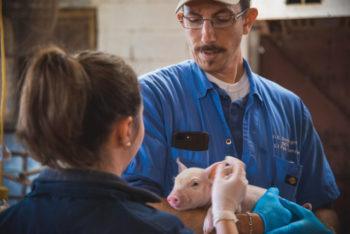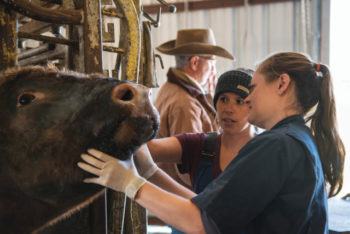Teaming Up For Texas
Across Texas, there are 104 prison units. At 42 of those units, there are inhabitants that some might not expect: multitudes of horses, cows, pigs, chickens, and dogs.
The cows, pigs, and chickens are raised to help feed the prison population, and the horses and dogs are raised to help with security. The animals’ day-to-day care is handled by the offenders—but the animals still need regular medical care.
For that, Texas A&M’s College of Veterinary Medicine & Biomedical Sciences (CVM) steps in, partnering with the Texas Department of Criminal Justice (TDCJ) to provide veterinary care to TDCJ’s farm operations in one of the longest-term interagency agreements between state agencies.
“Nobody knows exactly when or how the partnership started,” said Dr. Brandon Dominguez, a clinical associate professor in the CVM’s Department of Large Animal Clinical Sciences (VLCS), who oversees the program for the CVM. “But with time, we’ve built this relationship where we trust TDCJ with what they do really well, which is security and raising animals, and they trust us with what we do really well, which is providing veterinary care and teaching veterinary students.”
“It’s a win-win for both organizations,” agreed Bobby Lumpkin, TDCJ’s division director for manufacturing, agribusiness, and logistics. “If we didn’t have the partnership with Texas A&M, who would provide veterinary care for our cattle and livestock? It also benefits A&M, because we’re A&M’s biggest laboratory for the students.”
Across that “laboratory,” there are more than 10,000 cattle, 1,400 horses, 19,000 swine, 1,200 dogs, and a quarter million chickens. The diversity and quantity of animals housed at the prison units gives veterinary students a unique opportunity to learn about herd health management and population medicine.
Every two weeks, five fourth-year veterinary students on the mixed animal, equine, or food animal tracks do a rotation working with TDCJ animals. The work starts early and takes students all over the state. The students, Dominguez, and two other supervising professors, Dr. Jennifer Fridley and Dr. Eric Kneese, visit 13 of the 42 locations regularly and visit the remaining locations quarterly or semiannually.
“We usually start our day at about 6:30 in the morning and drive to whatever unit we’re working on that day,” Dominguez said. “There are units stretched from McAllen to Dalhart and from El Paso to just outside of Texarkana, so sometimes we have overnight trips.”
When the CVM team arrives, they get to work, assisted by the TDCJ farm managers and trustees, the nonviolent, short-term offenders who provide the day-to-day animal care.
“Depending on what is necessary each day, the work could range from doing pregnancy examinations on cows to deworming horses or doing surgery on dogs,” Dominguez said. “We might also float teeth in horses, collect blood from pigs or chickens for regulatory work, or examine animals that are sick or injured.”
By providing veterinary care for the animals that TDCJ raises to support the offenders, veterinary students are also helping the Texas economy.
“TDCJ’s agriculture program and the animals we raise are very important for the agency, as they help provide food, security, and job skills for the offenders,” said Ron Hudson, TDCJ’s deputy division director for manufacturing, agribusiness, and logistics. “Texas A&M provides our animals with veterinary care, and students also provide assessments such as nutritional values (of the feed) the livestock consume. If TDCJ didn’t have a partnership for the veterinary service, it would be a challenge, logistically and economically, to assure the health of the animals over such a vast area.”
Dr. Jennifer Fridley and fourth-year veterinary student Danielle Garnier examine an abscess on the face of a young bull.
But the partnership between TDCJ and the CVM provides so much more than just an economic benefit. It gives veterinary students the opportunity to apply their understanding of individual animal care at a population level.
“In the TDCJ rotation, there are a lot of opportunities to see how larger operations manage their herds,” said Trent Dozier, a fourth-year veterinary student from Abilene who is focusing on large animal medicine. “It’s been really beneficial.”
Working with a population of animals changes the equation of care. Students must consider the range of possible problems and assess how each problem applies to the entire herd, such as with pregnancy rates.
“We try to piece together the full story to see what we need to do to give all those cows a better chance at becoming pregnant,” Dominguez said.
Getting hands-on, herd-level experience also helps students gain confidence, as it did for Danielle Garnier, a fourth-year veterinary student from Houston who would like to do her residency in small animal surgery.
“I had not felt super comfortable doing some large animal things, like tubing horses in emergencies,” Garnier said. “But after this rotation, I feel 100 percent ready to do that should the need arise.”
Dominguez, Lumpkin, and Hudson are encouraged by the success of the rotation and are looking forward to expanding the partnership.
“Going forward, TDCJ is moving toward the holistic angle. We’ve discussed letting the students assess the cattle pre-birth and after-birth and conduct assessments on pastures for improvement,” Hudson said. “We continue to build on our relationship to make the partnership stronger by learning ways to offer A&M students experiences that will benefit them post-graduation and collaborating to utilize the available services A&M can offer TDCJ.”
For Dominguez, the partnership has become a “full-circle” experience; he did the TDCJ rotation himself when he was a veterinary student in the CVM. He joined the CVM as a faculty member in 2010 after completing his master’s degree in epidemiology and a few years in general practice.
“When I came through vet school I had a strong desire to go into mixed animal practice,” Dominguez said. “But in the back of my mind, I wanted to come back and teach. With this partnership, we have a unique arrangement where we can give the students a lot of free reign to make decisions and practice all the skills that we’ve taught them in the first three-plus years of vet school and let them really learn to become veterinarians in a rural, mixed-animal setting. The students do the procedures (and) make the decisions, and I step in and help when they need it.”
For Victoria Mundo, a fourth-year veterinary student from Cypress who wants to work in small animal general practice, this supported independence has made all the difference.
“We’re not just sitting back and watching a resident or intern do a procedure,” Mundo said. “Here, we get to float all of the teeth; we get to work with the pigs; we get to do the procedures. There have been a lot of early mornings, but it’s fantastic.”
This article by Chantal Cough-Schulze originally appeared on the CVM website.





